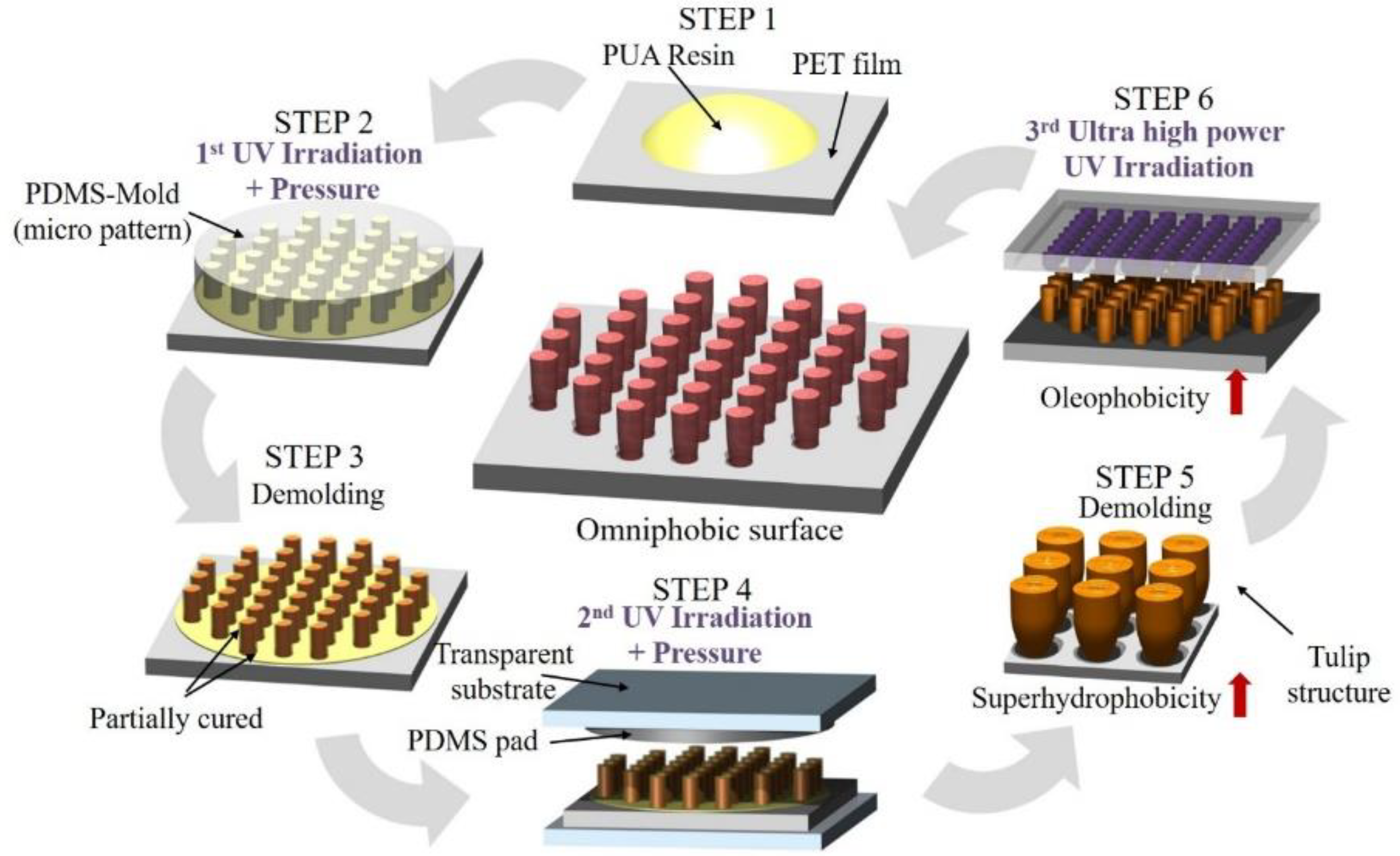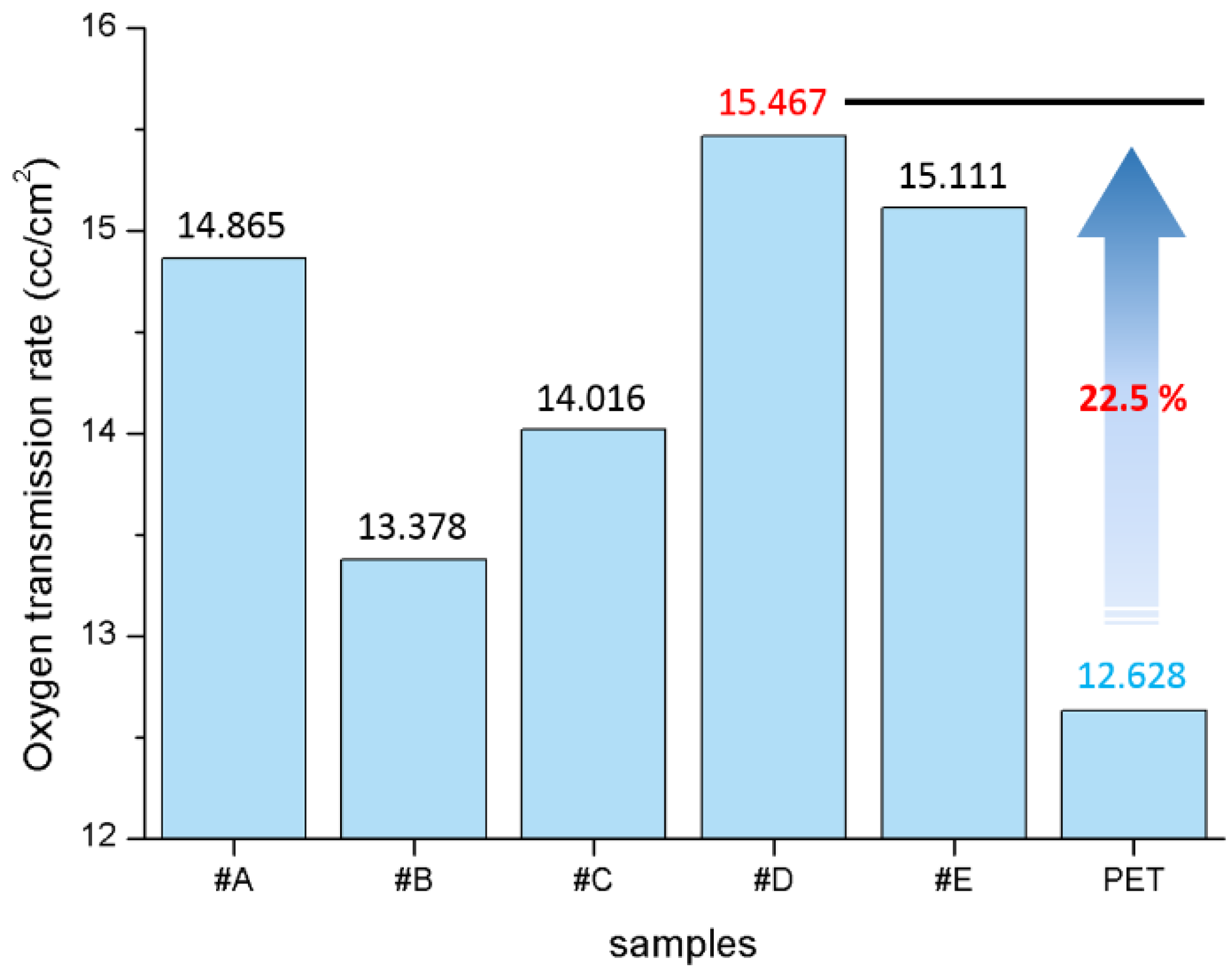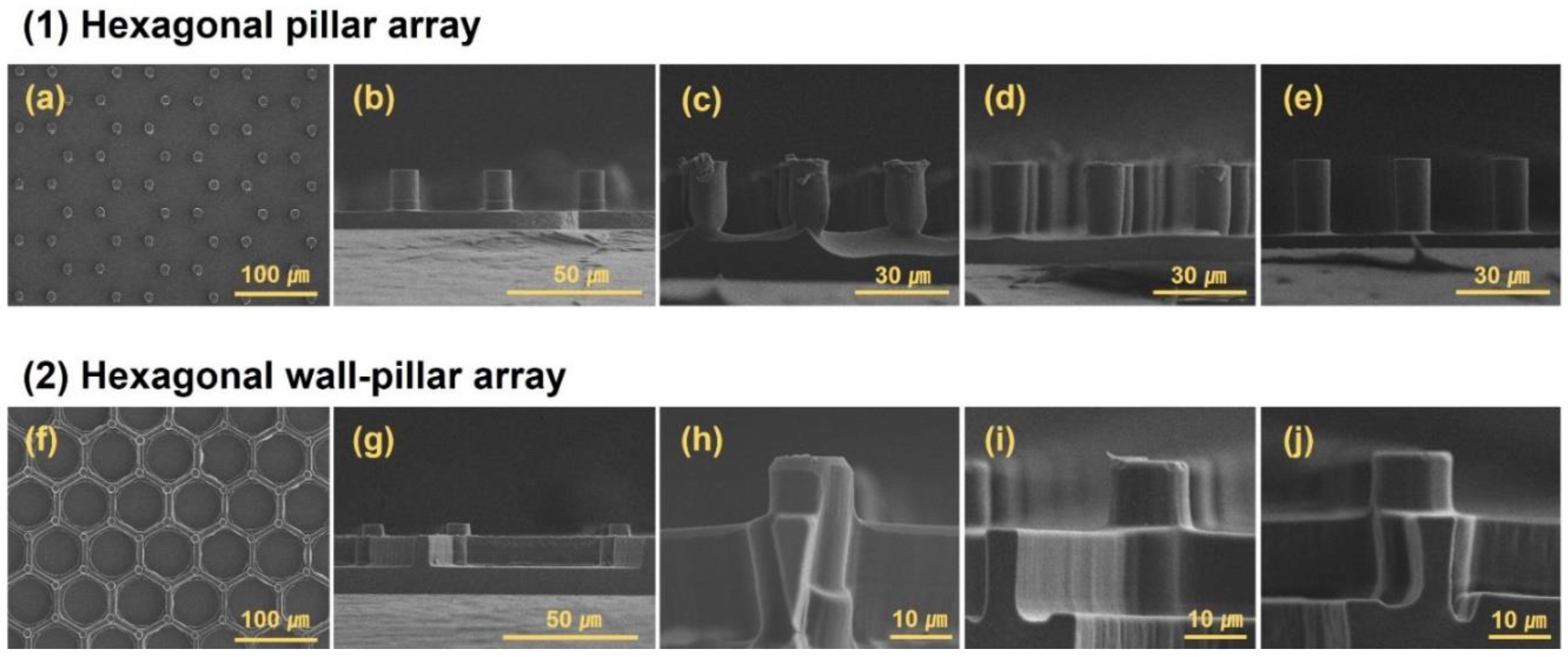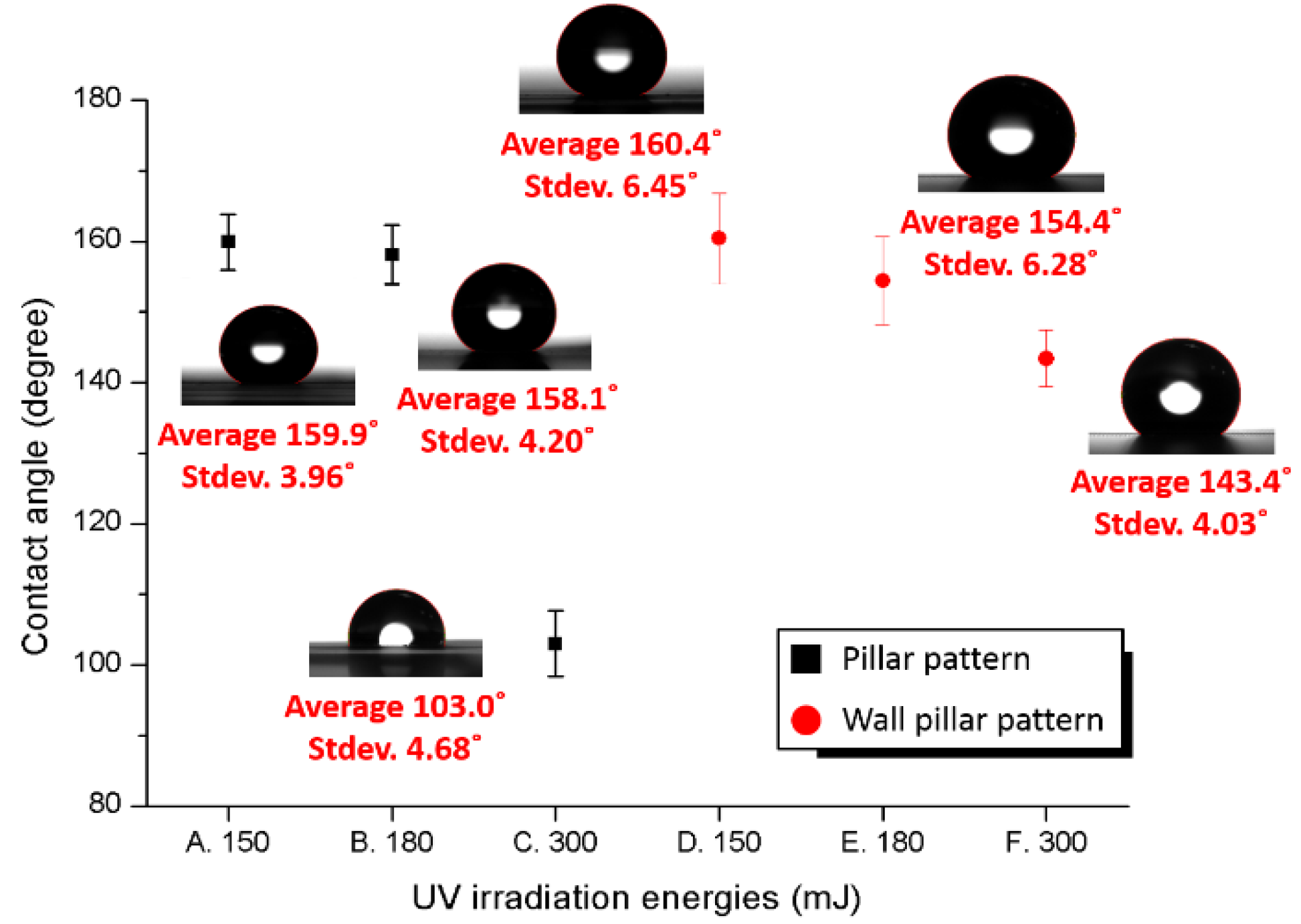Tulip-Shaped Pattern Imprinting for Omni-Phobic Surfaces Using Partially Cured Photopolymer
Abstract
1. Introduction
2. Process Design and Experiments
2.1. Design of The Tulip-Shaped Pattern Imprinting Process
2.2. Determination of PDMS Combination Ratio
2.3. Comparison of Micro-Pattern Morphology Before and After Experiments
2.4. Micro-Pattern Deformation Mechanism
2.5. Final Curing Process for Improving Durability of Micro-Pattern
3. Conclusions
Author Contributions
Funding
Institutional Review Board Statement
Informed Consent Statement
Data Availability Statement
Conflicts of Interest
References
- Gao, X.; Yan, X.; Yao, L.; Xu, L.; Zhang, K.; Zhang, J.; Yang, B.; Jiang, L. The dry-style antifogging properties of mosquito compound eyes and artificial analogues prepared by soft lithography. Adv. Mater. 2007, 19, 2213–2217. [Google Scholar] [CrossRef]
- Watson, G.S.; Cribb, B.W.; Watson, J.A. How micro/nanoarchitecture facilitates anti-wetting: An elegant hierarchical design on the termite wing. ACS Nano 2010, 4, 129–136. [Google Scholar] [CrossRef]
- Pazhanimala, S.K.; Vllasaliu, D.; Raimi-Abraham, B.T. Engineering biomimetic gelatin based nanostructures as synthetic substrates for cell culture. Appl. Sci. 2019, 9, 1583. [Google Scholar] [CrossRef]
- Bormashenko, E.; Gendelman, O.; Whyman, G. Superhydrophobicity of lotus leaves versus birds wings: Different physical mechanisms leading to similar phenomena. Langmuir 2012, 28, 14992–14997. [Google Scholar] [CrossRef]
- Koch, K.; Bhushan, B.; Barthlott, W. Diversity of structure, morphology and wetting of plant surfaces. Soft Matter. 2008, 4, 1943–1963. [Google Scholar] [CrossRef]
- Bhushan, B.; Jung, Y.C. Micro-and nanoscale characterization of hydrophobic and hydrophilic leaf surfaces. Nanotechnology 2006, 17, 2758–2773. [Google Scholar] [CrossRef]
- Liu, Y.; Li, X.; Jin, J.; Liu, J.; Yan, Y.; Han, Z.; Ren, L. Anti-icing property of bio-inspired micro-structure superhydrophobic surfaces and heat transfer model. Appl. Surf. Sci. 2017, 400, 498–505. [Google Scholar] [CrossRef]
- Lee, H.; Lee, B.P.; Messersmith, P.B. A reversible wet/dry adhesive inspired by mussels and geckos. Nature 2007, 448, 338–342. [Google Scholar] [CrossRef] [PubMed]
- Liu, K.; Jiang, L. Bio-inspired self-cleaning surfaces. Annu. Rev. Mater. Res. 2012, 42, 231–263. [Google Scholar] [CrossRef]
- Bar-Cohen, Y. Biomimetics—using nature to inspire human innovation. Bioinspir. Biomim. 2006, 1, 1–12. [Google Scholar] [CrossRef]
- Narazaki, A.; Oyane, A.; Miyaji, H. Laser-Induced Forward Transfer with Optical Stamp of a Protein-Immobilized Calcium Phosphate Film Prepared by Biomimetic Process to a Human Dentin. Appl. Sci. 2020, 10, 7984. [Google Scholar] [CrossRef]
- Bhushan, B.; Jung, Y.C. Natural and biomimetic artificial surfaces for superhydrophobicity, self-cleaning, low adhesion, and drag reduction. Prog. Mater. Sci. 2011, 56, 1–108. [Google Scholar] [CrossRef]
- Bentivoglio Ruiz, C.; Machado, L.; Volponi, J.; Segura Pino, E. Oxygen inhibition and coating thickness effects on UV radiation curing of weatherfast clearcoats studied by photo-DSC. J. Therm. Anal. Calorim. 2004, 75, 507–512. [Google Scholar] [CrossRef]
- Studer, K.; Decker, C.; Beck, E.; Schwalm, R. Overcoming oxygen inhibition in UV-curing of acrylate coatings by carbon dioxide inerting, Part I. Prog. Org. Coat. 2003, 48, 92–100. [Google Scholar] [CrossRef]
- Studer, K.; Decker, C.; Beck, E.; Schwalm, R. Overcoming oxygen inhibition in UV-curing of acrylate coatings by carbon dioxide inerting, Part II. Prog. Org. Coat. 2003, 48, 101–111. [Google Scholar] [CrossRef]
- Kwak, R.; Park, H.H.; Ko, H.; Seong, M.; Kwak, M.K.; Jeong, H.E. Partially cured photopolymer with gradient bingham plastic behaviors as a versatile deformable material. ACS Macro Lett. 2017, 6, 561–565. [Google Scholar] [CrossRef]
- Manoudis, P.N.; Karapanagiotis, I. Modification of the wettability of polymer surfaces using nanoparticles. Prog. Org. Coat. 2014, 77, 337–338. [Google Scholar] [CrossRef]
- Feng, L.; Zhang, Y.; Xi, J.; Zhu, Y.; Wang, N.; Xia, F.; Jiang, L. Petal effect: A superhydrophobic state with high adhesive force. Langmuir 2008, 24, 4114–4119. [Google Scholar] [CrossRef] [PubMed]
- Cao, L.; Hu, H.H.; Gao, D. Design and fabrication of micro-textures for inducing a superhydrophobic behavior on hydrophilic materials. Langmuir 2007, 43, 4310–4314. [Google Scholar] [CrossRef]
- Karlsson, M.; Forsberg, P.; Nikolajeff, F. From hydrophilic to superhydrophobic: Fabrication of micrometer-sized nail-head-shaped pillars in diamond. Langmuir 2009, 26, 889–893. [Google Scholar] [CrossRef]
- Wang, S.F.; Chiang, C.C. A notched long-period fiber grating magnetic field sensor based on nanoparticle magnetic fluid. Appl. Sci. 2016, 6, 9. [Google Scholar] [CrossRef]
- Memon, F.A.; Morichetti, F.; Melloni, A. Waveguiding light into silicon oxycarbide. Appl. Sci. 2017, 7, 561. [Google Scholar] [CrossRef]
- Wang, C.J.; Ke, Y.; Shiu, G.Y.; Chen, Y.Y.; Lin, Y.S.; Chen, H.; Lin, C.F. InGaN Resonant-Cavity Light-Emitting Diodes with Porous and Dielectric Reflectors. Appl. Sci. 2021, 11, 8. [Google Scholar] [CrossRef]
- Durret, J.; Szkutnik, P.D.; Frolet, N.; Labau, S.; Gourgon, C. Superhydrophobic polymeric films with hierarchical structures produced by nanoimprint (NIL) and plasma roughening. Appl. Surf. Sci. 2018, 445, 97–106. [Google Scholar] [CrossRef]
- Pan, L.; Dong, H.; Bi, P. Facile preparation of superhydrophobic copper surface by HNO3 etching technique with the assistance of CTAB and ultrasonication. Appl. Surf. Sci. 2010, 257, 1707–1711. [Google Scholar] [CrossRef]
- Ozaki, R.; Ishida, K.; Morita, E.; Hanada, Y. Nanoparticle Deposition of Fluoropolymer CYTOP via Holographic Femtosecond Laser Processing and Its Biochip Application. Appl. Sci. 2020, 10, 7243. [Google Scholar] [CrossRef]
- Cao, L.; Price, T.P.; Weiss, M.; Gao, D. Super water-and oil-repellent surfaces on intrinsically hydrophilic and oleophilic porous silicon films. Langmuir 2008, 24, 1640–1643. [Google Scholar] [CrossRef]
- Bellanger, H.; Darmanin, T.; De Givenchy, E.T.; Guittard, F. Influence of intrinsic oleophobicity and surface structuration on the superoleophobic properties of PEDOP films bearing two fluorinated tails. J. Mater. Chem. A 2013, 1, 2896–2903. [Google Scholar] [CrossRef]
- De Leon, A.C.C.; Pernites, R.B.; Advincula, R.C. Superhydrophobic colloidally textured polythiophene film as superior anticorrosion coating. ACS Appl. Mater. Inter. 2012, 4, 3169–3176. [Google Scholar] [CrossRef]
- Bhushan, B.; Jung, Y.C. Wetting, adhesion and friction of superhydrophobic and hydrophilic leaves and fabricated micro/nanopatterned surfaces. J. Phys. Condens. Mat. 2007, 20, 225010. [Google Scholar] [CrossRef]
- Li, M.; Xu, J.; Lu, Q. Creating superhydrophobic surfaces with flowery structures on nickel substrates through a wet-chemical-process. J. Mater. Chem. 2007, 17, 4772–4776. [Google Scholar] [CrossRef]
- Huang, J.; Ge, S.; Wang, H.; Chen, R. Study on Preparation and Properties of Intrinsic Super-Hydrophobic Foamed Magnesium Oxychloride Cement Material. Appl. Sci. 2020, 10, 8134. [Google Scholar] [CrossRef]
- Song, J.S.; Park, Y.S.; Kim, N.H. Hydrophobic Anti-Reflective Coating of Plasma-Enhanced Chemical Vapor Deposited Diamond-Like Carbon Thin Films with Various Thicknesses for Dye-Sensitized Solar Cells. Appl. Sci. 2021, 11, 358. [Google Scholar] [CrossRef]
- Chen, Z.; Liu, X.; Wang, Y.; Li, J.; Guan, Z. Highly transparent, stable, and superhydrophobic coatings based on gradient structure design and fast regeneration from physical damage. Appl. Surf. Sci. 2015, 359, 826–833. [Google Scholar] [CrossRef]
- Wenzel, R.N. Surface roughness and contact angle. J. Phys. Chem. 1949, 43, 1466–1467. [Google Scholar] [CrossRef]
- Wenzel, R.N. Resistance of solid surfaces to wetting by water. Ind. Eng. Chem. 1936, 28, 988–994. [Google Scholar] [CrossRef]
- Cassie, A.B.D.; Baxter, S. Wettability of porous surfaces. T. Faraday Soc. 1944, 40, 546–551. [Google Scholar] [CrossRef]
- Celia, E.; Darmanin, T.; De Givenchy, E.T.; Amigoni, S.; Guittard, F. Recent advances in designing superhydrophobic surfaces. J. Colloid Interf. Sci. 2013, 402, 1–18. [Google Scholar] [CrossRef]
- Wang, S.; Liu, K.; Yao, X.; Jiang, L. Bioinspired surfaces with superwettability: New insight on theory, design, and applications. Chem. Rev. 2015, 115, 8230–8293. [Google Scholar] [CrossRef] [PubMed]
- Zhu, P.; Kong, T.; Tang, X.; Wang, L. Well-defined porous membranes for robust omniphobic surfaces via microfluidic emulsion templating. Nat. Commun. 2017, 8, 15823. [Google Scholar] [CrossRef]
- Seo, D.; Cha, S.K.; Kim, G.; Shin, H.; Hong, S.; Cho, Y.H.; Chun, H.; Choi, Y. Flexible and stable omniphobic surfaces based on biomimetic repulsive air-spring structures. ACS Appl. Mater. Inter. 2019, 11, 5877–5884. [Google Scholar] [CrossRef] [PubMed]






| Sample | Base (wt %) | Curing Agent (wt %) | Softening Agent (wt %) |
|---|---|---|---|
| #A | 76.1 | 10.9 | 13 |
| #B | 78.3 | 8.7 | 13 |
| #C | 79.7 | 7.3 | 13 |
| #D | 75 | 8.3 | 16.7 |
| #E | 72 | 8 | 20 |
Publisher’s Note: MDPI stays neutral with regard to jurisdictional claims in published maps and institutional affiliations. |
© 2021 by the authors. Licensee MDPI, Basel, Switzerland. This article is an open access article distributed under the terms and conditions of the Creative Commons Attribution (CC BY) license (http://creativecommons.org/licenses/by/4.0/).
Share and Cite
Choi, S.H.; Kim, D.H.; Kim, S.; Kim, W.Y.; Kim, S.; Cho, Y.T. Tulip-Shaped Pattern Imprinting for Omni-Phobic Surfaces Using Partially Cured Photopolymer. Appl. Sci. 2021, 11, 1747. https://doi.org/10.3390/app11041747
Choi SH, Kim DH, Kim S, Kim WY, Kim S, Cho YT. Tulip-Shaped Pattern Imprinting for Omni-Phobic Surfaces Using Partially Cured Photopolymer. Applied Sciences. 2021; 11(4):1747. https://doi.org/10.3390/app11041747
Chicago/Turabian StyleChoi, Su Hyun, Do Hyeog Kim, Seonjun Kim, Woo Young Kim, Seok Kim, and Young Tae Cho. 2021. "Tulip-Shaped Pattern Imprinting for Omni-Phobic Surfaces Using Partially Cured Photopolymer" Applied Sciences 11, no. 4: 1747. https://doi.org/10.3390/app11041747
APA StyleChoi, S. H., Kim, D. H., Kim, S., Kim, W. Y., Kim, S., & Cho, Y. T. (2021). Tulip-Shaped Pattern Imprinting for Omni-Phobic Surfaces Using Partially Cured Photopolymer. Applied Sciences, 11(4), 1747. https://doi.org/10.3390/app11041747







